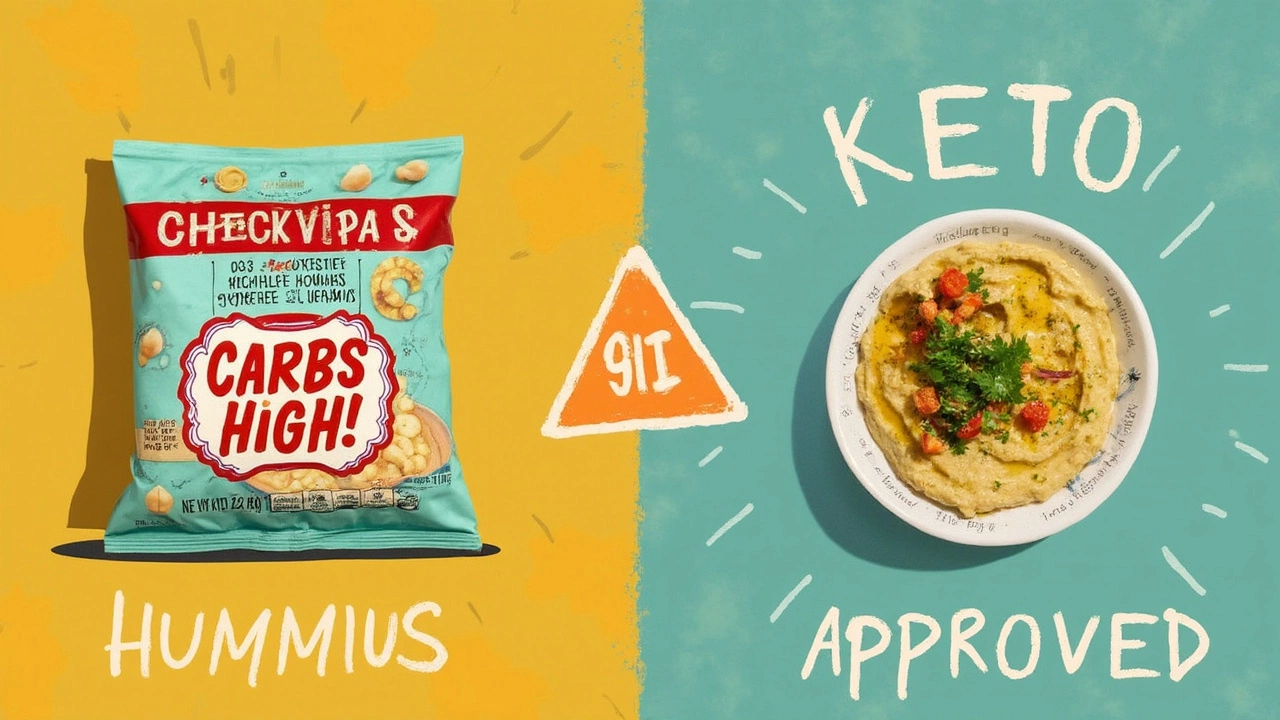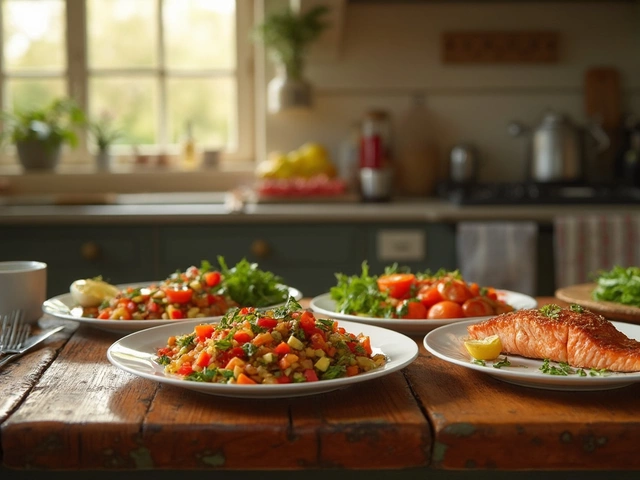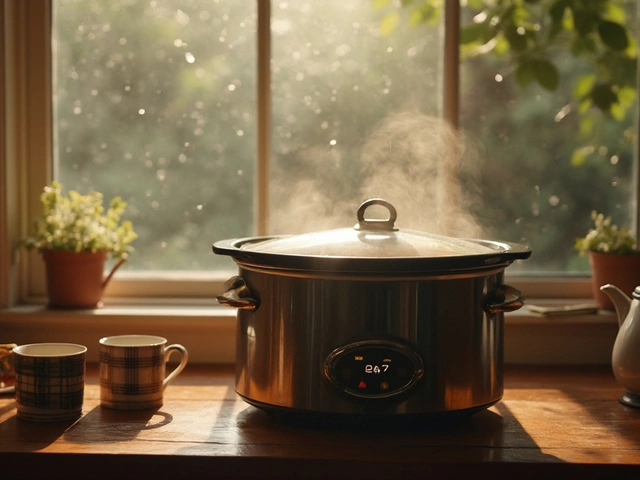Pull out a veggie stick and you might wonder—does hummus mess up my keto game? The answer isn't a simple yes or no. You hear people call hummus healthy, but for keto folks, it all comes down to the numbers. Chickpeas, the main star in hummus, pack more carbs than you might expect in a tiny scoop. If you're fiercely counting every gram, even a couple of tablespoons can tip you over your daily carb goal.
Some think they can eat piles of hummus because it ‘feels’ light, but that's a sneaky trap. Most store-bought hummus clocks in at around 3-4 grams of net carbs per tablespoon. Do the math—3 or 4 quick dips and you’re already pushing past half your carb limit for the day. Yeah, yikes!
But it’s not all bad news. Not all hummus is created equal, and you’ve got options if you’re not ready to give up that creamy, garlicky flavor. There are tricks to make it work, whether you want to tweak a recipe at home or hunt down a magic low-carb version at the store. You can even swap chickpeas for other ingredients and still call it hummus (well, sort of—your taste buds won’t care).
- What’s Actually in Hummus?
- How Many Carbs Are We Talking?
- Store-Bought vs. Homemade: Does It Matter?
- Smart Hummus Swaps for Keto
- How to Enjoy the Dip Without Ditching Your Goals
What’s Actually in Hummus?
The basic stuff in hummus is super simple. We’re talking chickpeas (sometimes called garbanzo beans), tahini (that’s just ground-up sesame seeds), lemon juice, olive oil, garlic, and salt. That’s the traditional version, but brands and home cooks love to throw in extras like roasted red peppers, cumin, or even beets. So, it’s worth always checking what’s in your tub or recipe if you’re picky about ingredients.
Where most people get tripped up is the carbs in hummus—and that’s mostly because of the chickpeas. Chickpeas are legumes, so while they give you protein and fiber, they do have more carbs than, say, cauliflower or eggs. Tahini and olive oil? They’re not the problem—both are low in carbs and pretty keto-friendly.
If you’re a numbers person, here’s a breakdown of what you might find in two tablespoons (about 30 grams) of classic hummus:
| Ingredient | Role | Carbs per 2 tbsp (approx.) |
|---|---|---|
| Chickpeas | Base | 4-5g |
| Tahini | Creaminess, flavor | 1g |
| Olive Oil | Texture, fat | 0g |
| Lemon Juice | Tang | <1g |
| Garlic | Flavor | <1g |
| Salt & extras | Seasoning | 0g |
That carb load mostly comes from the chickpeas. If you’re just eating a spoonful, you might stay under your limit. Eat with abandon, and the carbs pile up quick. Always check labels on store versions too—some sneak in sugars or starchy fillers to boost texture or shelf life, which is not great if you’re watching every carb.
Short version? Hummus is simple, but the chickpeas are the wildcard. If you’re strict keto, even basic hummus can become a once-in-a-while treat unless you make a clever swap (we’ll get to that soon).
How Many Carbs Are We Talking?
This is the part where things get real. Most people don’t realize that chickpeas (the heart of hummus) are naturally pretty high in carbs, and that’s not ideal if you’re sticking close to a keto or low-carb plan. For a quick snapshot, a standard store-bought hummus serving—about two tablespoons—packs in 5 to 6 grams of total carbs and around 3 to 4 grams of net carbs after you subtract the fiber. That’s the average you’ll see on labels like Sabra, Tribe, and most grocery brands.
Here’s a quick rundown of the numbers:
- Sabra Classic Hummus: 2 Tbsp = 5g total carbs, 2g fiber, so about 3g net carbs.
- Tribe Classic Hummus: 2 Tbsp = 4g total carbs, 1g fiber, so roughly 3g net carbs.
- Homemade hummus (classic recipe): 2 Tbsp = about 5g total carbs, 1g fiber, so 4g net carbs.
Doesn’t sound like much, right? But if your daily net carb target is 20 grams (a common keto number), just 4 tablespoons—what most people use for a snack—can cost you 6 to 8 net carbs. That’s a huge chunk gone, and we haven’t even talked about what you’re dipping yet.
As Dr. Eric Westman (author of “The New Keto Diet Revolution”) puts it: “Chickpeas are healthy, but the carb count in hummus can be a real obstacle for strict keto diets.”
Bottom line, the strong keto keyword here—if you want to keep hummus in your life, keep the serving size tiny. Or, start thinking about creative swaps and tweaks, because those carbs add up fast.

Store-Bought vs. Homemade: Does It Matter?
When it comes to hummus on a keto diet, not all dips are equal. The difference between what comes in a tub at the store and what you blitz up at home can seriously change how many carbs you’re eating. Most store-bought brands use the classic chickpea formula, which isn’t exactly low-carb. Some even add sneaky extras like starch, sugar, or extra oil to improve texture or flavor, which means more hidden carbs per swipe.
Check out this quick comparison for a real-world look at what you’re up against. The serving size is two tablespoons (about 30g):
| Brand/Type | Net Carbs | Fat | Protein |
|---|---|---|---|
| Sabra Classic Hummus (Store) | 4g | 5g | 2g |
| Cedar’s Original (Store) | 3g | 5g | 2g |
| Homemade (Traditional) | 5g | 4g | 2g |
| Keto Cauliflower Hummus (Homemade) | 1g | 6g | 1g |
See the catch? Even so-called simple store brands have 3–4 grams of net carbs. Homemade classic hummus is usually the same or slightly more, depending on your recipe. That’s because chickpeas—no matter what—bring the carbs. But if you make it yourself, you control what goes in. Want to skip the chickpeas and swap in things like cauliflower or zucchini? Suddenly, your "hummus" (okay, it’s not exactly traditional) drops to just 1 net carb per serving.
Here are a few smart tips if you’re aiming for the lowest possible carbs:
- Always check nutrition labels on store-bought dips for added sugars or starches.
- If you go homemade, swap chickpeas for low-carb vegetables like cauliflower or avocado.
- Stick with just olive oil, lemon juice, garlic, and tahini for flavor—skip the honey, beans, or weird fillers.
- Control your portion size: two tablespoons max per snack if you’re eating the real stuff.
Bottom line: if you want hummus to fit your keto lifestyle, homemade is the safest play. You call the shots, and your carb count drops fast. Don’t trust the front of the package—check the back, check the math, and if you’re not sure what’s in it, whip it up yourself. Your macros will thank you.
Smart Hummus Swaps for Keto
Want that creamy dip without blowing your carb limit? Good news—there are some tasty swaps that’ll keep you in the keto zone. The trick is to swap out chickpeas for low-carb veggies and still get that hummus vibe with way fewer carbs.
Cauliflower is the all-star here. Steam it, drain it well, and blend it with your classic hummus add-ins: tahini, lemon juice, garlic, olive oil, and a pinch of cumin. Same color, same creamy texture, and way fewer carbs. Here’s a quick look at carb counts:
| Ingredient (per 100g) | Net Carbs (g) |
|---|---|
| Chickpeas (canned, drained) | 14 |
| Cauliflower (cooked) | 2.3 |
| Zucchini (raw) | 2.1 |
| Eggplant (cooked) | 3 |
Notice how big that drop is when you kick chickpeas out of the picture? Some folks even use avocado as a base for a green spin on hummus, mashing it with tahini and garlic. Not traditional, but it’s seriously tasty and keeps the carb count low.
If you want to try a keto “hummus,” here’s a basic method with cauliflower you can whip up fast:
- Steam about 2 cups of cauliflower florets until very soft.
- Drain extra water and let them cool for a few minutes.
- In a food processor, combine cauliflower, 2 tablespoons tahini, juice from half a lemon, 1 small garlic clove, 1 tablespoon olive oil, salt, and cumin to taste.
- Blend until it’s super smooth. Adjust seasoning if you need.
This swap gives you all the flavor, but only about 2 grams of net carbs per serving. If you’re grabbing a pre-made “hummus” at the store, check the label for ingredients and carbs—some brands have started releasing cauliflower, zucchini, or even almond-based dips aimed at keto folks, but you’ve got to read the fine print. Food companies love to call anything with tahini "hummus," even if they sneak in starches or beans, so don’t get tricked by fancy packaging.
The bottom line: your dip doesn’t have to be boring. Just tweak the main ingredient and you can hang onto hummus while sticking to your carb goal.

How to Enjoy the Dip Without Ditching Your Goals
If you’re following a strict keto or low carb plan, there’s no need to swear off dips. You just need a smart game plan—starting with paying attention to every carb that sneaks into your bowl. Chickpeas are higher in carbs, but a little creativity means you can still satisfy those cravings without wrecking your progress.
First up, watch how much you scoop. A heaping spoonful here and there can add up fast. Measure your portions instead of guessing—2 tablespoons is a pretty good serving size for most people on keto, keeping you under 7-8 grams of net carbs if you go for classic hummus.
| Type | Serving Size | Net Carbs (g) |
|---|---|---|
| Classic Hummus | 2 tbsp | 6 |
| Cauliflower Hummus | 2 tbsp | 2 |
| Avocado Hummus | 2 tbsp | 3 |
If you want to go even lower, swap regular hummus with one of these low carb substitutes. Cauliflower-based hummus is a game changer, and it gives you that same creamy texture without blowing your carb budget. Avocado hummus is another option that brings healthy fats into the mix, perfect for staying in ketosis.
And don’t forget what you’re dunking. Toss the pita and crackers, and try these instead:
- Sliced cucumber, celery sticks, or bell pepper strips
- Radish chips—crunchy and super low carb
- Mini romaine leaves, great for scooping
If you like making food at home, blend up your own batch and skip the store’s hidden sugars and starches. Tweak classic recipes—swap most of the chickpeas for steamed cauliflower or zucchini. Hit it with plenty of tahini, olive oil, lemon juice, and garlic. The flavor stays bold, but the carbs drop big-time.
Stay mindful of your carb goals, and you can still sneak a taste of your favorite dip. Keto doesn't mean missing out; it just means knowing what’s in your bowl. Once you get a handle on the keto numbers, you’ll always have a snack that fits your plan.








Write a comment